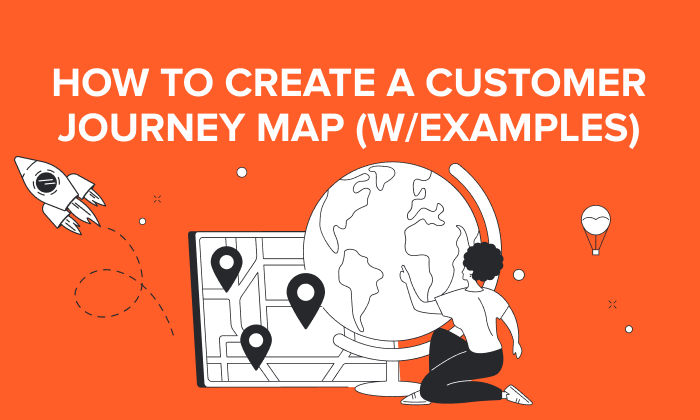
Creating a customer journey map is enough to make even the best marketers freeze in their tracks and realize how little they really know about their prospects.
If this sounds like you, don’t worry.
Even if you’ve never created a buyer persona before, I’ll help you make sense of the process by giving you a guide to better understand who your customers are and what they want.
Let’s take a closer look.
What Is A Customer Journey Map?
A customer journey map is a diagram that illustrates each step in the buyer’s journey, including who the customer is, what their needs are, and what objections they may have.
This map makes it easier for sales, marketing, and executive teams to make more informed decisions while humanizing your audience and making them easier to target.
The first step in a customer journey map is the core demographics, such as:
- Gender
- Age range
- Job title
- Job responsibilities
- Salary
- Region
- Company size
You’ll likely find most of this data in your CRM. If not, a survey can give you a clear picture of who your audience is and what they do.
I recommend “humanizing” the persona by giving them a name and image. This brings out more of our emotional, empathetic side versus looking at the potential customer as a number to slot somewhere in a sales funnel.
Different Stages of the Customer Journey
When mapping out the customer journey, there are different stages that businesses need to be aware of. By understanding these stages, companies can create a more seamless and effective map that leads to conversions and customer satisfaction.
Let’s take a look:
Awareness Stage
The customer journey map begins with awareness, which means when the prospect becomes aware of your product or service.
They may see an ad, read an article online, or hear about your business from a friend at this stage.
Comparison Stage
This is when customers look at the various options and compare them side by side. Typically, they look at features, prices, and reviews to decide which product is right for them.
The comparison phase is crucial because it’s where customers make their final decision. If you can influence them during this part, you can increase your chances of making a sale.
Decision Stage
The decision stage is the final stage of the customer journey map when the customer either makes or does not make a purchase. Many factors, such as price, product quality, and customer service, influence the decision stage.
Now that you have the basics, let’s see what this looks like in practice.
Customer Journey Map Example
For our customer journey example below, we’ve chosen to work with Lucy, a marketing director in her late 40s.
Her job primarily entails lead generation, sales management, and gathering competitive intelligence.
She organizes and prioritizes campaigns; she’s a pro at gathering competitive intelligence and uses it wisely to reinforce the brand while cementing customer loyalty in a highly competitive marketplace.
Due to the increase in popularity of social media, Lucy’s looking to streamline the interaction process on social media without losing the “personality” of the brand.
She’s in the market for a solution and wants to make a confident decision quickly.
With this in mind, our persona map looks something like this so far:

Now we’ve got a persona, what about the buyer’s needs?
How To Understand the Buyer’s Needs
Buyers are eager to tell you what they need. All you have to do is ask.
Basic lead follow-up and nurturing questions can reveal quite a bit. Additionally, simple polls and surveys can often show a great deal about where the buyer is in the process (and whether they have an urgent need for your product or service versus basic curiosity).
Even if we don’t know specifically what they need, we can make a few general statements and apply them to our persona.
Returning to the example above, ask yourself, what would someone in this job typically need from our solution?
- For starters, the buyer likely needs the product to be well-documented. She’ll be managing dozens, perhaps hundreds, of staff members, some of whom may be more technically savvy than she is.
- Some staff may pick it up quickly; others may need more time. We’ll add the needs and the persona’s place in the decision-making process (one persona can have multiple roles in the decision process; they can be a user and initiator, for example)
- Is the solution adaptive and flexible to accommodate the buyer’s existing platforms and tools?
- Does the purchaser have procedures and requirements to add to the mix, like cloud-based access and specific security protocols?
- These factors can influence and even conflict with what the primary buyer wants.The internal stakeholders often make decisions like these, which lengthens the required time and features.
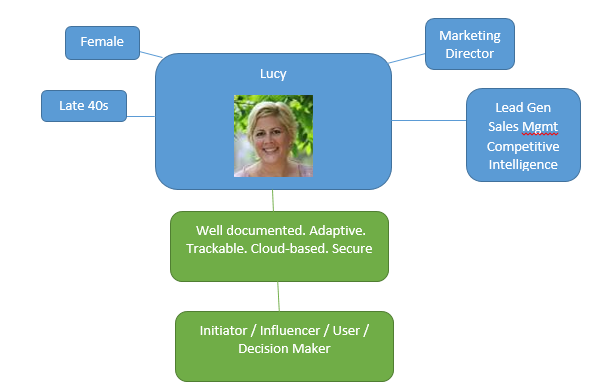
Dealing with Common Roadblocks in Customer Journey Maps
During the customer journey, constraints, concerns, frustrations, and issues often affect the buying decision. These roadblocks will prevent your customer from taking action, so you need to outline those in your map.
You can brainstorm these obstacles and add them to your customer journey map to ensure that your sales team knows how to address the most common objections before becoming major pain points.
You also have to decide where this buyer falls on the decision-making scale.
Will they be using the product, influencing the decision-maker, or perhaps just initiating contact with the company? Could they be a mix of all of these?
On your map, note these roadblocks and the buyer persona’s place in the decision-making cycle.
Following our example, we end up with something like this:
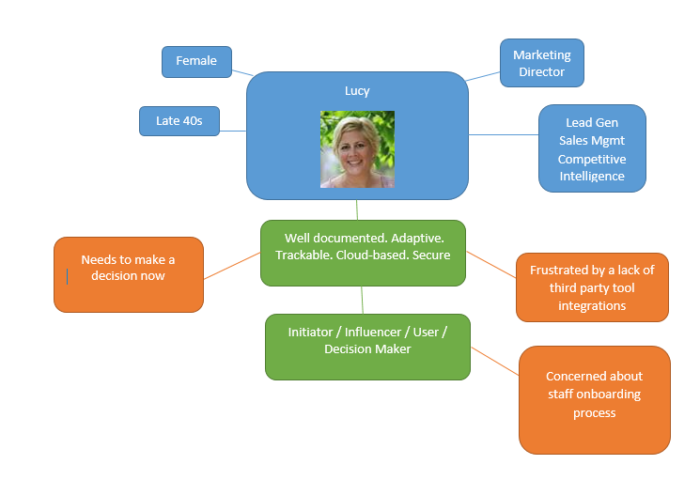
Here, we’ve managed to discover (and brainstorm) the buyer’s potential:
- Needs
- Concerns
- Frustrations
- Urgency/Timeframe to Buy
- Place in the buying cycle
- Requirements
As the list above shows, all the kinds of sales-propelling information needed to acknowledge objections, concerns, and frustrations while concentrating on needs, requirements, and urgency.
We’ve learned core demographics about our buyers and key information that may prevent them from taking action or details that could move a sale into the next stage.
Our customer journey map is less of a neatly-organized, bulleted list and more like a mind map that’s always being adjusted and revised. It may not be as tidy, but it’s closer to the actual customer experience and, therefore, far more useful
In other words, our customer journey map puts you in the buyer’s shoes. The buying decision is rarely a simple one, and the model we’ve designed allows a more accurate look at how people think when planning a purchase.
Create a Customer Journey Map for Each Type of Customer
Now, you must go through this entire process with every type of buyer your company encounters. Each type of customer will have a different buyer path, objections, and challenges. For example, in retail, you’ve got suppliers, wholesalers, resellers, and a whole avalanche of personas out there.
Need some inspiration? Here are some customer journey map examples:
You can break customer journey maps into smaller parts for more complex situations and focus on different areas, like the e-commerce checkout process.
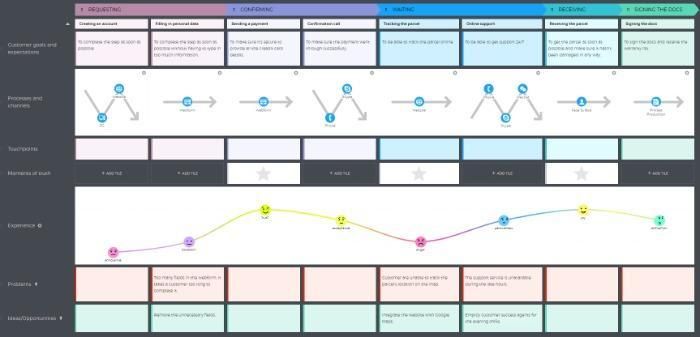
Another approach is to create a customer journey map for specific features like Spotify did.
Spotify wanted to track playlist-creation touchpoints through a third-party app to understand customers’ emotions better.
By using customer journey mapping, Spotify found its users were reluctant to share their playlists in case others judged their musical tastes. Additionally, Spotify found some users didn’t know about the feature.
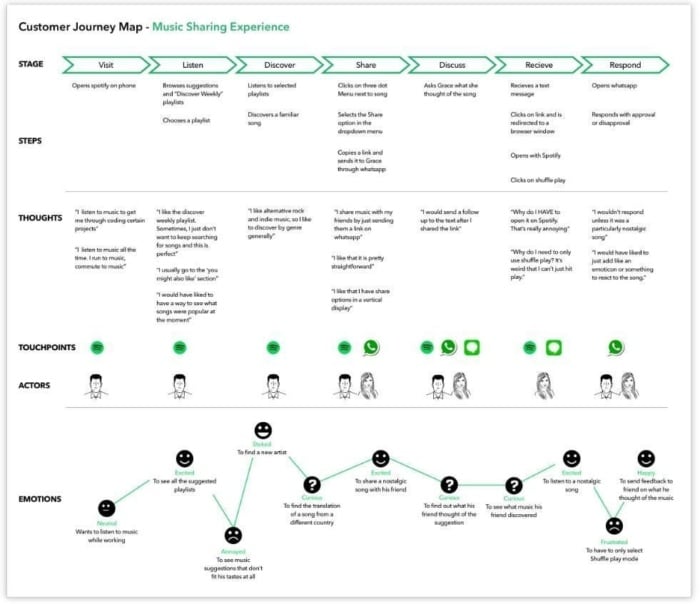
Spotify responded to this by improving its user interface and in-app flows to refine the customer experience and improve touchpoint relevance along the way.
The above are just two customer journey map examples; buyer journeys are also a key part of PPC campaigns.
The Customer Journey and Your Marketing Strategy
As a business, you want to ensure that your marketing strategy aligns with your customer’s journey. Here are some steps to help you do that.
First, you’ll need to identify your customer’s various touchpoints with your brand. This could include everything from visiting your website to speaking with customer service.
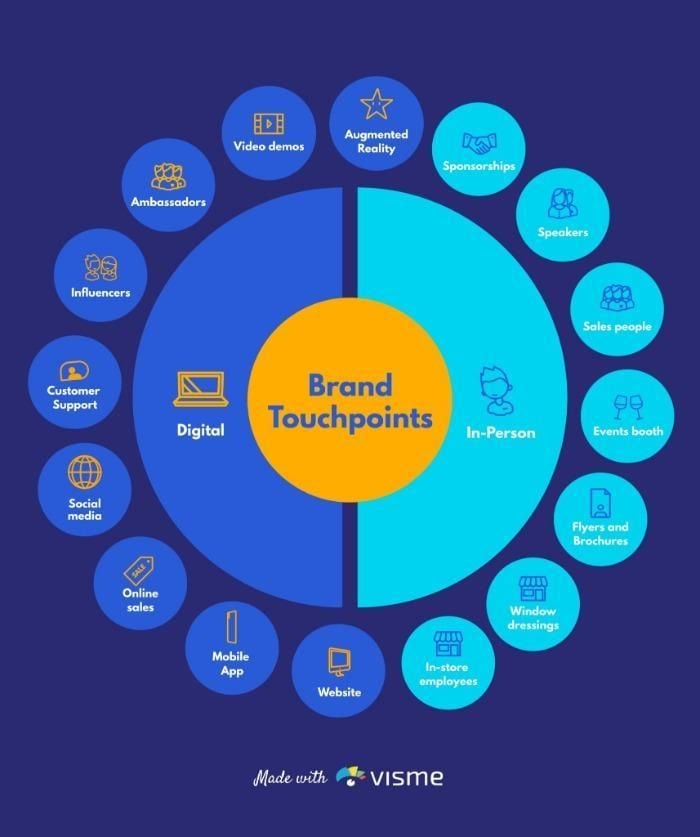
You can use marketing attribution (the process of measuring which specific marketing activities are driving results for your business) to help you identify these touchpoints.
Next, you’ll consider the customer’s emotional state at each journey stage. What do they need? Answering these questions will help you create a more effective customer journey map.
Finally, don’t forget to consider the overall purpose of the customer journey map and how it ties in with your market strategy. What do you want your customers to achieve? Once you have a clear goal, you can start mapping out the steps needed to get there.
Customer Journey Maps and Content Creation
Creating content for each stage of the customer journey is an effective way to guide your prospect all the way to the purchase point.
By providing helpful, informative, and engaging content, you can keep your customers engaged and nurture them to become lifelong fans of your brand.
I’ve listed some content ideas for each stage of the journey.
The Pre-purchase (Awareness) Stage
The pre-purchase stage is all about education. Your potential customers are trying to learn more about their options and what would be the best fit for them. They’re looking for unbiased information to help them make a decision.
That’s where your content comes in. Providing them with helpful information that answers their questions helps them narrow down their options and make informed decisions.
Types of content you could create include:
- Blog posts
- Social media content
- Ebooks
- Case studies
The Consideration Stage
During the consideration stage, your customers make up their minds about which product or service to choose. They’re looking for reassurance that they’re making the right choice. How can you help them along? Try content like:
- Product comparisons
- Ebooks
- Blog posts and videos explaining more about the product
- Email marketing (Focusing on the product/service your lead is interested in).
The Purchase Stage
Your prospect is about to make their decision but might have some doubts. What content can you give them that may get them over the line and turn them into a fully-fledged customer? Try:
- Product information guides
- FAQs
- Pre-sale support through email, chat, and social media
- Email marketing
Finally, remember to look after your customer post-purchase. Ensure your client gets the best from the product/service with how-to guides, product updates, and access to customer service support.
FAQs
What Is a Customer Journey Map?
A customer journey map is a diagram that shows the steps a customer takes during their journey with a company. It includes all touchpoints where the customer interacts with the company, from first contact to post-purchase follow-up.
What is Customer Journey vs Customer Experience?
The customer journey represents all the summed up actions and interactions that a customer has with a given brand. The customer experience represents how a business interfaces with customers at every touch point. So customer experience plays a big role in the customer journey, but the two things aren’t the same.
What Are the Most Common Customer Journey Stages?
While your team may add additional steps depending on your market and audience, the most common customer journey steps are:
- Awareness
- Consideration
- Purchase
- Retention
- Advocacy
What Are the Five Reasons to Use a Customer Journey Map?
Five reasons to use a customer journey map include:
1. Improved communication with customers.
2. Better understanding of customer needs.
3. Identifying potential problems before they happen.
4. Taking a proactive approach to customer service.
5. Saving time and money by resolving issues quickly.
What Should A Customer Journey Map Include?
First, it should clearly outline the various touchpoints a customer has with your brand, from initial awareness to purchase and beyond.
It’s also important to consider the emotions and needs of customers at each stage of their journey. What are they trying to accomplish? What are their pain points? Addressing these questions will help you create a holistic view of the customer experience.
Finally, don’t forget to include data! Collecting data points at each stage of the customer journey will give you valuable insights into your customer demographics and how best to market to them.
Conclusion
Don’t panic. Prioritize.
Focus on your most profitable customers first and find the unifying threads that tie them together, then build on that persona. Once you have those, start working down the list until you have all your customer journeys mapped.
Additionally, remember that buyers are multi-faceted human beings.
Sometimes they make decisions that go against the grain of even the most well-developed persona. It happens.
However, when you have a better idea of who your customers are, you can build more effective conversion funnels that make it easy for buyers to take the action you want them to take.
Are you planning to create a customer journey map? What is holding you back?
from Neil Patel https://ift.tt/5wy9OFU

No comments:
Post a Comment